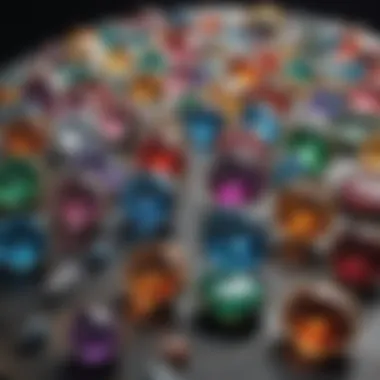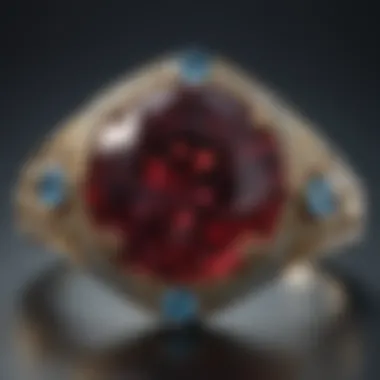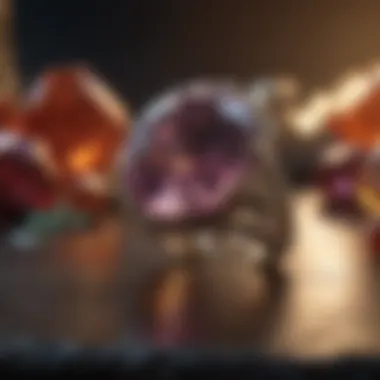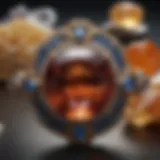Exploring Gemstones: A Comprehensive Guide to Selecting Stones for Rings


Intro
Choosing a gemstone for a ring can be a profound and fulfilling journey. Gemstones offer not just beauty but also personality. Each stone has its own story, character, and significance. This article will guide you through the intricacies of selecting the right gemstone for your unique taste and occasion.
Overview of Gemstones and Minerals
History of Gemstone and Mineral Use
The history of gemstones and their use in jewelry goes back thousands of years. Ancient civilizations, including the Egyptians and Greeks, had deep appreciation for these natural wonders. They believed gemstones held mythical powers and brought good luck. Numerous gemstones were used not only for adornment but also as symbols of status and power. For instance, the use of turquoise in ancient Egypt was a sign of truth, protection, and health.
Significance in Culture and Society
Gemstones often have rich meanings in many cultures. A diamond might symbolize everlasting love in western cultures, while ruby signifies passion in other societies. Birthstones, for example, assign specific gems to each month and carry unique meanings. The wide-ranging significance of gemstones makes them important pieces in societal traditions and personal narratives, often tied intricately to milestones such as engagements, marriages, and anniversaries.
Gemstone Formation and Properties
Formation Process of Gemstones
Most gemstones originate deep within the Earth. They form through various geological processes, including crystallization from magma, metamorphic transformation of existing stones, or sedimentary from organic material. The reminiscence of these processes often plays a vital role in their unique appearance and forms.
Properties that Define Gemstones
Gemstones have specific properties that set them apart. These include hardness, color, luster, and clarity. The quality of a gemstone can be determined by analysing each of these aspects. The harder the stone, the more durable it is. Luster relates to how light interacts with the gemstone surface. Each gemstone's unique qualities merit careful consideration.
Classification based on Color, Hardness, and Luster
Gemstones can be classified into different categories based on their physical properties. Color ranges widely, from deep reds to bright greens, with shades influencing desirability. The Mohs scale of hardness ranks gemstones, ranging from talc at one to diamond at ten. The luster is categorized into types such as metallic, vitreous, and pearly, creating distinct appearances.
Types of Gemstones
Precious vs.
Semi-Precious Gemstones
Traditionally, gemstones are classified into two groups: precious and semi-precious. Precious gemstones, including diamond, emerald, ruby, and sapphire, are known for their rarity and value. Semi-precious gemstones, such as amethyst and peridot, are often more abundant, yet equally beautiful.
Common Gemstone Varieties
Several gemstone varieties are well-known and commonly sought, like:
- Amethyst
- Sapphire
- Topaz
- Garnet These stones are favored for their variety of colors and properties, providing data-rich choice to consumers.
Exotic and Rare Gemstones
Every collector longs for the unique sparkle of exotic gems. Stones such as painite or red beryl can be quite rare, adding an element of exclusivity to a collection. Elusive gems can require careful attention and come with compelling stories, captivating the collector’s interest.
Identifying and Evaluating Gemstones
Factors Affecting Gemstone Value
A gemstone's value can be influenced by a variety of factors, including rarity, size, quality, and source. Stones from renowned regions often fetch higher prices due to their reputation. Certification from recognized entities can also significantly impact value, as it provides proof of a gem's authenticity.
Techniques for Gemstone Identification
Identifying genuine gemstones from synthetic or imitation stones is critical. Some common techniques include:
- Magnification: Examining inclusions fails natural stones.
- Hardness tests: Conducting scratch tests assists in verification.
- Refractive index measurements: Distinct between different stones.
Assessing Gemstone Quality
Quality assessment involves scrutinizing clarity, cut, and color. The Four Cs guide this process—color, clarity, cut, and carat weight. Each aspect plays a unique role in ensuring the gemstone meets desired standards.
Caring for Gemstones
Cleaning and Storing Gemstones Properly
Proper maintenance involves regular cleaning and appropriate storage. Different gemstones may require different cleaning methods. Warm, soapy water is often effective; however, cleaners should avoid harsh chemicals.


Avoiding Common Mistakes in Gemstone Care
It is important to take heed to avoid mistakes such as exposing gemstones to steep temperature changes or long-term sunlight exposure. These factors can cause extensive wear to the stone over time.
Preservation Tips for Specific Gem Types
Certain gems may need additional care:
- Opals: Should be kept away from heat to prevent drying.
- Pearls: Require separate storage from other stones, as they can scratch easily. Understanding and implementing care routines helps maintain the beauty and integrity of cherished gemstones.
Gemstones encapsulate centuries of cultural history and emotional resonance. Selecting the right stone is not just a choice; it's an exploration into personal meaning.
Preamble to Gemstones
Gemstones hold a significant place in the world of jewelry. Their vibrant colors, unique properties, and historical narratives intertwine with human culture and sentiment. This article aims to discuss various aspects of gemstones, guiding readers through their complexities and charm. By bringing an amalgamation of knowledge, this introduction serves as a bedrock for understanding how to select gemstones for rings, reflecting both personal style and the emotional value of specific stones.
The Importance of Gemstones in Jewelry
Gemstones are more than mere accessories; they are expressions of identity and emotion. In many cultures, they denote status, belief systems, and milestones. For example, a diamond represents enduring love, while sapphires symbolize wisdom and nobility. Each gemstone carries its own narrative and symbolism.
Genuine gemstones enhance the allure of any piece. They attract attention, whispering elegance and sophistication. Choosing a gemstone that resonates with a person’s life experience can transform a basic ring into a treasured heirloom.
Moreover, gemstones possess varied physical and optical properties. These variations contribute to their overall attractiveness. For instance, a ruby’s deep red can ignite passion, striking a powerful emotional chord than other stones. Additionally, ethical sourcing is gaining importance in the jewelry market. More consumers wish to make conscientious choices without compromising on beauty.
Historical Context of Gemstones in Rings
From ancient times to present day, gemstones have played significant roles in adornment. Through various eras, different stones gained popularity among the ruling classes and wealthy societies. Egyptian pharaohs adorned themselves with emeralds, believed to represent rebirth, while ancient Rome favored amethyst, valued for its purported ability to ward off intoxication.
Throughout history, rings adorned with gemstones symbolize commitment, ownership, and allegiance. When kings exchanged rings, they often represented promises or treaties. This tradition continues in modern engagements and weddings today. The halo effect around popular gemstones like the brilliant diamond traces back to customized stories and trends within noble families.
In summary, the history of gemstones in rings mirrors societal dynamics, personal connections, and evolving tastes, elevating them beyond being mere decorative items.
Ring design is influenced by these historical contexts, guiding current trends. Understanding this historical narrative enriches the journey of gem selection and deepens the significance of these ornamental choices. By observing trends in gemstone jewelry through time, individuals can better appreciate their selections and the heritage behind them.
Types of Gemstones
The selection of gemstones plays a crucial role in shaping personal style and enhancing the aesthetic appeal of rings. Understanding the types of gemstones is essential to make informed choices. Each type—precious and semi-precious—carries its own distinct charm, rarity, and significance. Knowledge about these distinctions aids both consumers and designers to identify the best stones that meet individual preferences and purposes in jewelry making.
Precious Stones Overview
Precious stones are generally recognized as rare and valuable gems. They include diamonds, sapphires, rubies, and emeralds. The value of these stones is influenced by several factors including rarity, beauty, and historical significance in different cultures. Each of these gemstones has unique characteristics which enhance their desirability in jewelry.
- Diamonds are the hardest natural material on Earth. Known for their brilliance and clarity, diamonds symbolize strength and eternal love. They play a major role in engagement rings.
- Sapphires, predominantly blue, can also appear in a spectrum of hues. They represent wisdom and royalty, often associated with nobility.
- Rubies are esteemed for their deep red color and vibrant appearance. They stand for passion and protection, making them a popular choice in various rings.
- Emeralds, valued for their rich green color and captivating clarity, symbolize rebirth and fertility. They have a long history as cherished stones in jewelry.
The combination of their physical attributes can make precious stones extraordinarily appealing in the context of rings. It is important to consider not only the aesthetic appearances of precious stones but also their hardness and durability for everyday wear.
Semi-Precious Stones Overview
Semi-precious stones, while not as rare or widely recognized as precious stones, possess their own unique qualities and appeal. This category encompasses a diverse range of gemstones such as amethyst, garnet, aquamarine, and opal. These stones often provide an excellent option for individuals seeking distinctiveness and personalization in their jewelry.
Some notable semi-precious stones include:
- Amethyst, known for its purple hue, is often linked to tranquility and balance. Its vibrant color can add a touch of luxury to any ring.
- Garnet comes in various shades but is most recognized for its deep red variant. It embodies the qualities of passion and devotion.
- Aquamarine, with its serene blue color, symbolizes peace and harmony. This clarity and freshness can elevate the visual appeal of rings.
- Opal, revered for its play-of-color, offers uniqueness that can complement bespoke designs dramatically.
Assessing semi-precious stones can present a rewarding opportunity to find pieces that align with personal values, aesthetic tastes, and budgets. Each semi-precious gemstone presents distinct features with diverse cultural meanings, providing personal touch or significance cherished by the wearer.
Understanding the differences between precious and semi-precious stones can greatly enhance one’s experience in selecting the perfect gemstone. As collectors and designers push these boundaries of personalization, the journey into the world of gemstones continues to expand.
Knowing your options allows for better representation of your individual style.
Properties of Gemstones
Understanding the properties of gemstones is vital for anyone aiming to choose the right stone for their rings. These characteristics play a substantial role in determining the overall aesthetics, durability, and emotional resonance of each piece. By evaluating the properties of gemstones, one can make informed decisions, ensuring that the final selection aligns with personal taste and occasion.
Physical Characteristics
Hardness
Hardness is often measured on the Mohs scale, which ranges from one to ten. Diamond, rated ten, is the hardest gemstone. This characteristic profoundly impacts durability and wearability. A high hardness rating signifies resistance to scratching and enhances the long-lasting nature of a ring.


Choosing a stone with high hardness is advantageous for everyday wear. However, stones with lower hardness like talc, rated at one, are not suited for rings meant for frequent use, as they can easily succumb to scratches.
Color
The color of a gemstone is one of its most visually striking attributes. Stones embody a broad spectrum of hues, from rich blues of sapphires to vibrant greens of emeralds. Color influences personal affinity and varies based on lighting and angle. Additionally, certain colors are often symbolic: blue for calmness, green for growth.
Color serves beneficial functions in jewelry. It helps express individuality and emotion. Bright and unique shades catch the eye, while muted tones may blend effortlessly into an existing wardrobe. Yet, these unique traits can also lead to difficulty in matching outfits or themes.
Clarity
Clarity succinctly describes the transparency of gemstones and the presence of internal imperfections or external blemishes. A gem with high clarity is devoid of significant inclusions and minor imperfections which can detract from its beauty.
Clarity holds significance in value—stones with exceptional clarity often carry higher prices. Choosing a gemstone with high clarity enhances its visual appeal, ensuring a more pristine appearance. However, some may prefer stones with inclusions for their organic allure and uniqueness.
Cut
The cut of a gemstone refers to how it has been shaped and faceted. A skilled cut maximizes a stone’s brilliance and fire. It affects light reflection, thereby playing a key role in defining its final aesthetic. Well-cut gems can exhibit more vivid colors and great brilliance, creating visual drama.
Although other factors matter, a quality cut is essential because it significantly affects the overall look of jewelry. It is essential to balance cut with stone type and size. An excessively deep or shallow cut may impact light performance, leading to undesirable results.
Optical Properties
Refraction
Refraction indicates how much light is bent when passing through a gemstone, affecting its sparkle. High refractive index stones, like diamonds, showcase excellent brilliance. Good refraction increases the visual impact of rings.
A crucial element in the aesthetic appeal of gemstones, refraction influences beauty. Though it is a complex attribute, it ultimately determines how the stone reflects light, enhancing the sparkle. However, it is important to note that while pushing for high refractive properties often lends greater brilliance, specific placements and cuts also matter significantly.
Luster
Luster describes how light interacts with the surface of a gemstone. For instance, pearls exhibit a soft glow, while diamonds shine with a brilliant sparkle. The luster impacts perceptions and is essential to how attractive the gemstone appears.
This characteristic contributes to a jewel's overall allure. A high luster can easily enhance a gem's visual worth. Sometimes, the less flashy luster of certain minerals may not contrast well with settings and metal tones, which may limit their appearances in choice settings.
Dispersion
Dispersion describes how light separates into its spectral colors. This characteristic is most notable in gems like diamonds and can result in stunning visual effects akin to a rainbow in a single stone. High dispersion can very well amplify a gem's beauty in a way that captivates observers.
This aspect significantly enhances how gemstones enchant with colorful light displays. While it can lead to greater appreciation and visual satisfaction, be reminded that too much dispersion might become distracting within the context of specific design choices.
Selecting Stones for Rings
Selecting stones for rings is a pivotal element in the journey of jewelry creation. A gemstone often serves as the centerpiece, setting the tone for the entire ring. Therefore, understanding how to select the appropriate stones is important for both aesthetic appeal and personal resonance.
When choosing stones, a wide range of aspects come into play. Evaluating personal style gives direction. Considering the occasion can offer insightful choices. Each selection should align with the wearer's identity and the significance of the event. Moreover, examining popular trends versus personal preferences can strike the right balance, making the selection process both unique and fulfilling.
Personal Style Considerations
Choosing a gemstone that resonates with the wearer's personal style can elevate the overall look of the ring significantly. Two dimensions involved in this decision are color preferences and stone size and shape.
Color Preferences
Color preferences reflect a wearer's individuality and should be a primary focus in selection. This aspect contributes significantly to creating a personal statement in jewelry. Each color evokes different feelings and meanings.
For example, blue sapphires symbolize integrity and calmness, presenting themselves as a popular choice in rings. The deep hues resonate well across cultures, making them a favorable pick. However, some colors may require more maintenance to keep their vibrancy. This can be a slight disadvantage for lighter or more delicate tones.
Unique features of personal color choices play a major role. It often extends beyond mere preference, representing encapsulated emotions, loyalty, and even fashion statements. Aligning ring colors with lifestyle choices enriches personal importance while enabling a wearer to express deeper connections.
Stone Size and Shape
Stone size and shape dictate both the look and function of the ring. Different shapes can lend distinct styles that cater to various personalities and occasions. A round-cut diamond, for instance, might suggest tradition, while an emerald cut may express character and individuality.
Size consideration allows the balance between presence and wearability. Larger stones make a statement but can sometimes be inconvenient for everyday wear. Conversely, smaller stones present elegance yet can be more subtle.
Shape relationships are often defined by light reflections. Different cuts exhibit light variances, contributing to unique visual experiences. However, intricate shapes may also require special considerations during engagement or repair. A pragmatic approach with gem size can actually yield profound advantages in crafting unique, meaningful jewelry.
Occasion-Specific Choices


Picking stones based on the occasion adds another layer of significance. For special events like engagements or anniversaries, each type of stone carries its unique characteristic that enhances meaning.
Engagement Rings
Engagement rings often signify one of life's most pivotal moments. This makes the choice highly significant, as it symbolizes love, commitment, and partnership. Traditional stones, such as diamonds, impact the perception of rings widely. Their durability and timeless appeal continue to make them a highly sought option.
However, there is a growing trend towards alternative gemstones. Many have begun exploring options like morganite or rubies for their inherently unique beauty and personal touch. These can offer distinctive stories instead of conforming to tradition.
A unique feature of engagement rings is how they often become treasured family heirlooms. Selecting a piece that tells a personal narrative or encapsulates a special story attributes deeper dimensions to the overall choice in gemstones.
Anniversary Rings
Anniversary rings also hold distinctive significance in a relationship. They often commemorate memories that span over years. Such rings may retain old stones or curled around new ones to celebrate renewal in love.
Color combinations and higher quality cuts tend to be chosen here more deliberately, aiming for longevity. Engaging with gems that signify a meaningful milestone, such as a garnet for a two-year mark, might further strengthen the relationship.
While both anniversary and engagement rings address significant milestones, the nuances they provide create depth in celebrating those valued memories. Selection here should merge personal reflection and versatile beauty to suit lifelong commitments.
Ethical Sourcing of Gemstones
Ethical sourcing of gemstones has gained significant attention in recent years. This focus goes beyond mere aesthetics and monetary value, addressing the human and environmental impacts of gemstone extraction and distribution. Consumers are now more informed and concerned about the origins of the products they purchase. This section will delve into several aspects that define ethical sourcing, discussing its benefits and the considerations it requires.
Conflict-Free Certification
Conflict-Free certification plays a vital role in ensuring that gemstones are obtained without financing violence or human rights abuses. This certification indicates that the stones have been sourced from areas not affected by conflict or exploitation. Various organizations and initiatives aim to monitor supply chains, establishing standards that guarantee the integrity of gemstones.
Moreover, conflict-free certification promotes transparency in the gemstone industry. Brands and retailers that adhere to these certifications often communicate their efforts to consumers. They do so through clear labeling and traceable product sources.
Understanding certification adds a layer of informed decision-making for consumers. Investing in conflict-free stones reflects personal values and supports ethical initiatives in the marketplace.
Sustainable Mining Practices
Sustainable mining practices are another essential aspect of ethical gemstone sourcing. These practices consider the long-term environmental, economic, and social impacts of mining activities. The goal is to minimize destruction while maximizing benefits for local communities and ecosystems.
Sustainable mining involves employing methods that are less harmful to the environment. Techniques like surface mining and excavation reduce waste and restore local habitats post-extraction. It can involve the use of advanced technology that ensures resource-efficient extraction processors.
Furthermore, local communities stand to benefit from sustainable practices. Mining projects that provide fair wages, community investment, and job creation contribute to a more balanced economic development. When communities thrive, it creates a stable environment where responsible sourcing practices can be maintained.
By prioritizing ethical sourcing, consumers align their purchasing decisions with values that advocate for social justice and environmental stewardship.
Caring for Your Gemstone Rings
Caring for your gemstone rings is not simply an act of maintenance; it’s an appreciation of the craftsmanship that goes into making a stunning piece of jewelry. Each gemstone carries its own unique properties and vulnerabilities, which means proper care is necessary for their longevity and beauty. Understanding how to care for these precious items can significantly enhance their aesthetics and primal value. Whether you own a diamond, sapphire, or an emerald, knowing how to keep these stones pristine is essential.
Cleaning Techniques
Keeping your gemstone rings clean is crucial for preserving their brilliance. Improper cleaning, on the other hand, may damage the stones or the settings they're in. Here are some suggestions to ensure effective cleaning without compromising quality:
- Gentle Soap and Water: A mixture of mild dish soap and warm water usually works well. Let the ring soak for about 20 to 30 minute. Use a soft brush, like a toothbrush, to gently scrub around the stone and its settings, especially in hard-to-reach areas.
- Ultrasonic Cleaners with Caution: Ultrasonic cleaners can be effective, but not all gemstones will withstand ultrasonic cleaning. Use caution, especially with soft stones like opal or pearls. Check if the cleaning is safe for your specific stone.
- Professional Cleaning: Sometimes rings can require more than a simple home cleaning job. Consider taking them to a jewelry professional for a deep clean, especially if they are heavily tarnished or dirty.
Remember to avoid cleaning agents that contain harsh chemicals. These can compromise stones like turquoise or those with other delicate properties. Regular care and tending to your jewelry can preserve its natural beauty for years.
Storage Recommendations
Appropriate storage is just as important as cleaning when it comes to caring for gemstone rings. Storing them improperly can lead to scratches, tarnish, and unintentional damage.
- Separate Storage: When not worn, store each ring separately to prevent scratches. Consider using soft pouches or individual sections in a jewelry box. This also reduces the risk of rings snagging on each other or surfaces.
- Cool, Dry Environment: Humidity and extreme changes in temperature can often lead to stone damage. Keeping your rings in a climate-controlled environment away from direct sunlight is best.
- Avoid the Bathroom: Storing rings in the bathroom is not advisable due to moisture levels. Instead, place them in a dedicated space, possibly in your bedroom.
By following these care tips, you not only assure the visual aspect of your gemstone rings but also extend their lifetime, maintaining both their monetary and sentimental value.
Closure
The conclusion section is pivotal for summarizing the various lessons presented throughout the article. Recognizing the integral nature of gemstones not just in jewelry but in cultural and historical contexts invites enthusiasts to value what they choose. The importance of personal exploration also shines here; each individual’s taste supports unique selections, making gems more than mere adornments but reflections of personality.
Recap of Key Points
- Significance in Jewelry: Gemstones carry rich meanings, adding emotional weight to items worn daily.
- Variety of Gemstones: The distinction between precious and semi-precious gems affects not just visual appeal but also considerations on rarity and pricing.
- Properties of Color and Clarity: Awareness of characteristics such as clarity and hardness is essential in maintaining longevity and luster.
- Pathway to Ethical Sourcing: Understanding conflict-free certifications supports responsible choices in gemstone procurement.
- Care for Longevity: Regular care techniques and proper storage enhance beauty and ensure these items can be passed down through generations.
Encouragement for Personal Exploration
Gemstone selection offers a personal journey. Each choice provides an opportunity for creativity. Explore various types not just in terms of aesthetic appeal but also where they originate from. Take time to appreciate subtle differences that make each stone special. Following a meaningful path can yield discoveries not only of specific stones but also of personal significance.
Consider each gem a vessel of your story, breathing life and emotion into proud individual expressions.
Gather thoughts through research and personal experiences. Friends or communities can also share in the learning process due to shared interests; gatherings of enthusiasts, online forums like Reddit, or even local shops can offer insight. Remember to take this time as an enriching part of your journey into the world of gemstones, solidifying knowledge based on both personal and community interactions.







